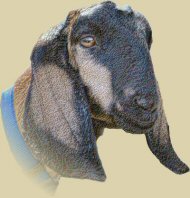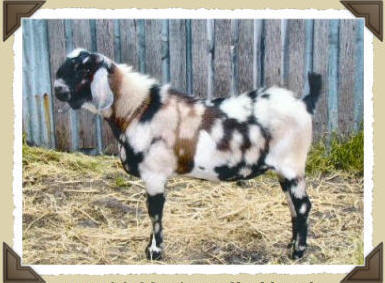

BACK
The Anglo Nubian Breed Standard
General Appearance (style & quality): The ideal is a large exotic animal with a high, proud head carriage, majestic bearing and upright stance. The goat should show the true attributes of sound dairy type.
Head (skull, eyes, ears, mouth, nostrils): Profile short and arched. Muzzle fine and tapered, nostrils flat, the teeth may extend beyond the dental pad. Ears long, broad and pendulous with little or no tendency to lift (as a guide, tips of ears should meet across nostrils). Eyes should be almond shaped and set wide apart.
Neck: Strong, medium length and without tassels, dewlap may be present on both bucks and does.
Backline: Straight back either level or slightly rising to hips. May show slight dip behind withers but with no sign of weakness.
Forequarters: Withers well defined, blending firmly into shoulders. Chest broad and deep.
Body (barrel): Heavy framed with good length and reasonable depth.
Legs (hooves): Legs strong and straight with no inclination to cow hocks or weak pasterns, which should be short, strong and upright.
Udder: Showing a broad attachment and no pocket, softly textured with a good capacity. Slight division allowed.
Testicles: Showing a broad attachment and no pocket, softly textured with a good capacity. Slight division allowed.
Teats: Two, of good size, set well apart and distinct from the udder.
Rudimentary teats: Two, set wide apart slightly to the fore and side of the scrotum, of good size but not overdeveloped, unless the buck is milking.
Size (height at withers): Does 32 inches (81 centimetres), Bucks 37 inches (94 centimetres).
Coat: short, fine and glossy
Colour: Any colour or combination of colours. May be plain (all one colour), broken coloured or mottled but should not carry full Swiss markings. Skin black, but may be grey with black pigmentation.
Differing from the ideal (found & recognised): Horned. Wry tail.
Faults: Fine bone and lack of size. Short, stiff ears. Straight face. Tassels. Cow hocks, dropped pasterns. Size differing substantially from the ideal. Visible teeth. Roach back or sway back. Tan skin. Poor feet. Splayed feet. Weak or narrow chest. Lack of dairy quality. Fleshy udder. Pocket in udder. Teats: small, thin, ill defined or unbalanced. Lack of milking capacity. Lack of masculinity in bucks. Unduly pendulous, divided or uneven scrotum.
